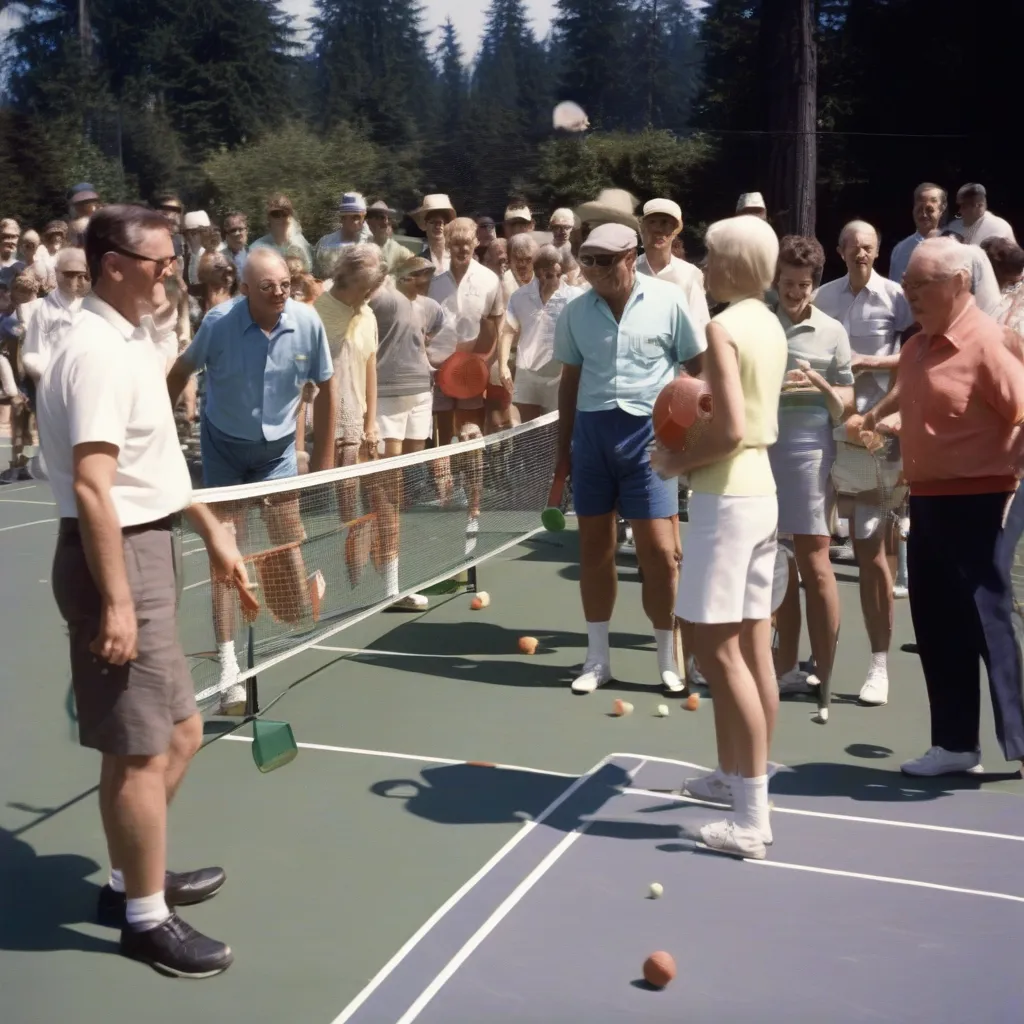Table of Contents
Introduction to the History of Pickleball
Pickleball, a sport that combines elements of tennis, badminton, and table tennis, has seen a remarkable surge in popularity over recent years. This game’s unique charm lies in its simplicity, accessibility, and the sheer fun it offers players of all ages. To truly appreciate Pickleball’s current status, it’s essential to delve into the fascinating history of Pickleball: its origins and evolution. The history of Pickleball is filled with interesting developments and milestones that have shaped it into the sport we know today.
The Birth of Pickleball
The origins of Pickleball date back to the summer of 1965 on Bainbridge Island, Washington. The story begins with three dads – Joel Pritchard, Bill Bell, and Barney McCallum – who were looking for a way to entertain their families. They wanted to create a game that everyone could play, regardless of age or skill level. Using a mix of badminton, tennis, and table tennis elements, they set up a net on a badminton court, handed out ping-pong paddles, and used a perforated plastic ball. Thus, the history of Pickleball began.
 History of Pickleball
History of Pickleball
Naming the Game
There are two popular theories about how Pickleball got its name. According to one account, it was named after Joel Pritchard’s dog, Pickles, who loved to chase the ball. However, Barney McCallum has stated that the game was named after the “pickle boat,” a term in rowing where oarsmen were chosen from the leftovers of other boats. Regardless of the true origin, the quirky name has certainly helped the sport stand out and adds a unique element to the history of Pickleball.
The Early Days of Pickleball
In its early years, Pickleball was primarily a backyard game, enjoyed by families and friends in their free time. The game continued to evolve, with the rules being standardized by the original creators. They determined that the net should be 36 inches high at the sidelines and 34 inches high at the center. The court size was set at 20 feet by 44 feet, the same dimensions as a doubles badminton court. These early decisions were crucial in shaping the history of Pickleball.
Development and Growth
As more people were introduced to Pickleball, the game began to grow beyond Bainbridge Island. Schools, community centers, and parks started to build courts and hold tournaments. The formation of the first official Pickleball tournament in Tukwila, Washington, in 1976 marked a significant milestone. This event helped to formalize the sport and increase its visibility, playing a key role in the history of Pickleball.
Formation of Governing Bodies
To manage the rapid growth and development of Pickleball, the USA Pickleball Association (USAPA) was established in 1984. The USAPA played a crucial role in promoting the sport, developing official rules, and organizing national tournaments. The creation of this governing body helped to standardize the game and ensure its growth at both grassroots and competitive levels, marking a significant chapter in the history of Pickleball.
Pickleball Goes Global
Pickleball’s popularity continued to rise throughout the 1990s and 2000s, spreading to other countries around the world. The simplicity of the game, along with the minimal equipment required, made it easy for new players to pick up and enjoy. International tournaments and the establishment of Pickleball associations in Canada, Spain, India, and other countries have contributed to the sport’s global reach. This global expansion is a notable part of the history of Pickleball.
The Modern Era of Pickleball
Today, Pickleball is one of the fastest-growing sports in the world. It boasts millions of players, numerous professional tournaments, and a growing number of dedicated Pickleball facilities. The sport has gained recognition and sponsorship from major sports brands, further solidifying its place in the global sports community. The continued innovation in equipment and training techniques ensures that Pickleball will remain a dynamic and engaging sport for years to come. This modern growth phase is an exciting period in the history of Pickleball.
Conclusion
The history of Pickleball is a testament to the sport’s universal appeal and the power of innovation in recreational activities. From its humble beginnings on Bainbridge Island to its current status as a global phenomenon, Pickleball has evolved into a beloved sport for people of all ages. Whether you’re a seasoned player or a curious beginner, understanding the origins and evolution of Pickleball adds a rich layer of appreciation for this dynamic and inclusive game. The history of Pickleball continues to be written as the sport grows and evolves.
Frequently Asked Questions
- Who invented Pickleball? Pickleball was invented by Joel Pritchard, Bill Bell, and Barney McCallum in 1965, marking the beginning of the history of Pickleball.
- Why is it called Pickleball? The name “Pickleball” either comes from Joel Pritchard’s dog, Pickles, or from the term “pickle boat” in rowing.
- When was the first Pickleball tournament held? The first official Pickleball tournament was held in Tukwila, Washington, in 1976, a key milestone in the history of Pickleball.
- What is the USA Pickleball Association? The USA Pickleball Association (USAPA) is the governing body established in 1984 to promote and standardize the sport, playing a vital role in the history of Pickleball.
- How has Pickleball grown globally? Pickleball has spread to numerous countries, with international tournaments and the formation of associations worldwide, expanding the history of Pickleball.
- Why is Pickleball so popular? Pickleball’s popularity is due to its simplicity, accessibility, and fun, making it appealing to players of all ages.